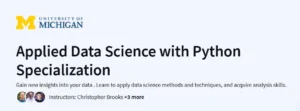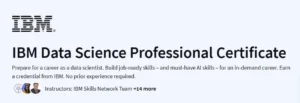What will you learn in A Practical Guide to Machine Learning with Python Course
Implement core machine learning algorithms in Python: linear regression, logistic regression, decision trees, random forests, SVMs, K-NN, and ensemble methods
Perform exploratory data analysis and preprocessing: handling missing values, feature scaling, one-hot encoding, and dimensionality reduction (PCA, clustering)
Validate and tune models using train/test splits, k-fold cross-validation, and hyperparameter search (grid/randomized search)
Build end-to-end predictive pipelines: data ingestion, model training, evaluation metrics, and deployment considerations
Program Overview
Introduction & Setup
⏳ 30 minutes
Topics: Course objectives, Python ML ecosystem (NumPy, pandas, scikit-learn), Jupyter notebook setup
Hands-on: Configure your environment and load a sample dataset
Exploratory Data Analysis
⏳ 2 hours
Topics: DataFrame operations, summary statistics, visualization with Matplotlib/Seaborn
Hands-on: Profile a dataset—identify distributions, outliers, and correlations
Data Preprocessing
⏳ 2 hours
Topics: Handling missing data, encoding categorical features, feature scaling (StandardScaler, MinMaxScaler)
Hands-on: Clean and transform data for modeling, build a reusable preprocessing pipeline
Unsupervised Learning & Feature Engineering
⏳ 2 hours
Topics: K-Means clustering, PCA for dimensionality reduction, feature construction
Hands-on: Cluster customers for segmentation and reduce feature space with PCA
Model Evaluation & Validation
⏳ 1.5 hours
Topics: Train/test split, k-fold cross-validation, evaluation metrics (MAE, MSE, accuracy, ROC AUC)
Hands-on: Compare multiple models on a benchmark dataset using cross-validation
Regression Algorithms
⏳ 3 hours
Topics: Linear regression, regularized regression (Ridge, Lasso), tree-based regressors
Hands-on: Predict housing prices; tune hyperparameters with GridSearchCV
Classification Algorithms
⏳ 3 hours
Topics: Logistic regression, K-NN, SVM, decision trees, random forests, gradient boosting
Hands-on: Build a classification pipeline for a medical-diagnosis dataset; evaluate with confusion matrices and ROC curves
Advanced Topics & Ensemble Methods
⏳ 2 hours
Topics: Bagging, boosting (AdaBoost, XGBoost), stacking, handling imbalanced classes with SMOTE
Hands-on: Improve model performance through ensemble stacking and balance techniques
Model Deployment & Next Steps
⏳ 1 hour
Topics: Saving models with joblib, basic Flask API for serving predictions, tips for production readiness
Hands-on: Wrap a trained model in a simple REST endpoint for real-time inference
Get certificate
Job Outlook
Data Analyst / ML Engineer: $85,000–$130,000/year — leverage ML to drive data-driven decisions in tech, finance, healthcare
Data Scientist: $95,000–$150,000/year — build and deploy predictive models to solve business problems
Machine Learning Engineer: $100,000–$160,000/year — productionize ML pipelines and scale machine learning solutions
Specification: A Practical Guide to Machine Learning with Python
|
FAQs
- No prior Quarkus experience required; beginner-friendly.
- Covers Quarkus CLI, Maven plugin, and project setup.
- Introduces microservice concepts with hands-on projects.
- Gradually builds REST, WebSocket, and GraphQL services.
- Emphasizes practical understanding of fault-tolerant microservices.
- Develop CRUD REST endpoints using JAX-RS.
- Build real-time chat microservices with WebSockets.
- Expose GraphQL APIs with SmallRye integration.
- Implement database persistence using Panache ORM and JDBC.
- Integrate fault tolerance with retries, circuit breakers, and health checks.
- Emphasizes microservice architecture and Quarkus features.
- Covers REST, WebSockets, GraphQL, and persistence.
- Does not cover Docker, Kubernetes, or advanced security protocols.
- Introduces reactive vs. imperative persistence briefly.
- Focuses on building deployable and resilient microservices quickly.
- Gain hands-on experience building resilient microservices.
- Learn REST, GraphQL, WebSocket, and database integration.
- Understand fault tolerance, retries, and circuit breakers.
- Prepare for job roles in cloud-native and backend development.
- Develop a capstone project for your portfolio.
- Hands-on exercises for each Quarkus module.
- Create REST endpoints, integrate APIs, and build WebSocket services.
- Expose GraphQL queries and mutations with real objects.
- Implement database persistence using Panache ORM.
- Capstone project combines all modules into a complete microservice application.





